 A common woe that most transcriptionists have to deal with almost on a daily basis is unclear dictation. No matter how carefully one listens to a digital audio recording, sometimes the most minor of background noises or interruptions can mar the flow of the words spoken. As a client, each transcript is important for official purposes and with a bit of effort put into clear dictations, you’ll find that your transcripts are delivered error free as well.
A common woe that most transcriptionists have to deal with almost on a daily basis is unclear dictation. No matter how carefully one listens to a digital audio recording, sometimes the most minor of background noises or interruptions can mar the flow of the words spoken. As a client, each transcript is important for official purposes and with a bit of effort put into clear dictations, you’ll find that your transcripts are delivered error free as well.
- The first tip is to ensure that any recording is done in a noise free environment. Although, this is quite an obvious point, cutting out absolutely any noise at all does take some practise. For instance, the sound of somebody typing away at a keyboard, a cell phone ringing in the background or even the sound of footsteps could interrupt the dictation. If possible, use a microphone that automatically cancels out any background noise or make a recording in a secluded room.
- It helps if a client is clear about whatever details or specifications are required in the transcript. That helps the transcriptionist to edit the document properly and give the appropriate finishing touches so that the document makes complete sense at a glance:
– Adding the right punctuation (for example, saying the word ‘ Full stop’ ) while dictating the text or giving the transcriptionist the freedom to decide where the proper punctuation marks should appear in the document is an important call to make.
– It helps to spell out proper nouns such as the name of a person or a place and to stress if you require certain words to be spelt out in capitals. Don’t forget to mention if you want to add a heading, a sub-heading, a title or a new paragraph during the dictation.
– Transcriptionists not only transcribe interviews or discussions, they also create meeting memos, e-mails and a host of other official documents. While uploading an audio file to your transcript agency, it makes sense to add a footnote highlighting the nature of the file as well. In case, you require transcripts on a regular basis, asking your transcriptionist to develop a few set templates for you will help speed things along.
- Speak in a pitch that’s neither too high nor low. Make sure your voice is audible; you speak slowly and with pauses included at the appropriate moments. It helps to make a short recording and then play it back, so that you can take note of any improvements that need to be made while making the actual dictation.
With a bit of practise, you’ll find that giving a good dictation is easier than you thought!





